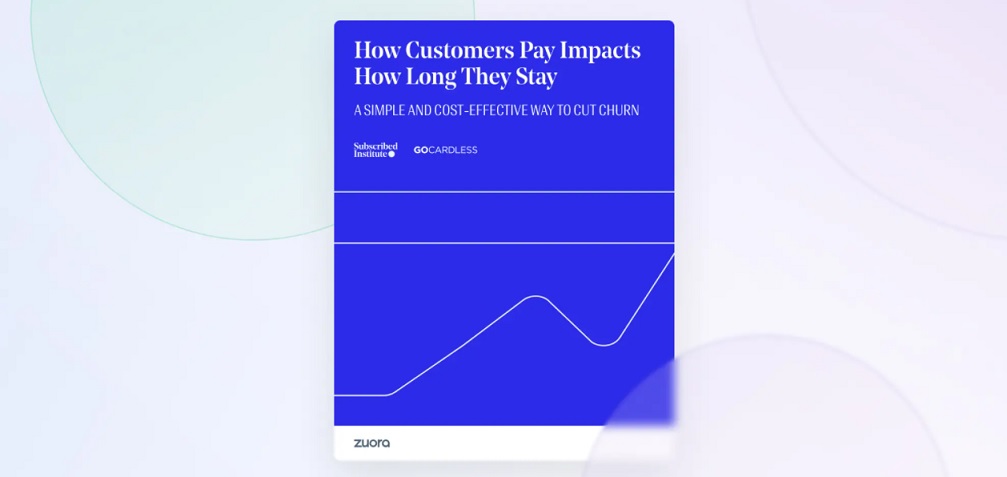
Whether customers pay with cards, bank transfer or other methods could mean the difference between thriving or barely surviving in the Subscription Economy.
Businesses that want to take advantage of the growing Subscription Economy® have a secret weapon to help them succeed – and getting it wrong could leave a large chunk of their customer base literally in the dark.
According to a new report from The Subscribed Institute at Zuora® and GoCardless, a company’s payment strategy plays a key role in their ability to reduce churn – or the proportion of customers they lose during a certain time frame.
The findings of the report, How Customers Pay Impacts How Long they Stay, reveal the annual customer churn rate for subscribers who pay via bank debit, known as ACH debit in the US, is just 4%. In contrast, the rate for those who pay via credit cards is over three times greater at 14%, and 16% for those using a digital wallet.
Churn has a huge impact on a business’ bottom line. The report finds that 20% to 40% of subscriber churn happens because of payment failure, and every quarter, subscription businesses needlessly lose between 1% and 6% of their customers. For a business with 100,000 transactions a month with an average transaction value of £15, that could mean a loss of up to £36.7 million in cumulative revenue over five years.
Credit cards, in particular, are prone to failure for a variety of reasons including something as simple as expired card details. With Strong Customer Authentication rules now fully enforced, enhanced security measures increase the risk of failure when payers sign up to subscriptions using credit cards. Bank payments, on the other hand, often include authentication in the checkout flow, making payments both safe and seamless. What’s more, bank accounts don’t expire and payment details never need to be updated.
Duncan Barrigan, Chief Product and Chief Growth Officer at GoCardless, said: “These findings indicate that businesses are suffering from preventable churn, resulting in losses that can run into millions of pounds. It doesn’t have to be this way. Shifting from card to bank payments will result in immediate and material benefits, not only in terms of reducing churn but also helping companies cater for changing consumer preferences, such as the desire to decrease their reliance on credit cards and debt. Making the transition is a win-win for both businesses and their payers.”
Amy Konary, Founder and Vice President, The Subscribed Institute at Zuora, said: “The growth of the Subscription Economy has put digital transformation firmly at the top of the agenda for many businesses. We’ve seen even more companies understand that subscriptions help create better experiences through ongoing customer relationships. While customer acquisition is a focus of all businesses, retention and expansion of these relationships is also a key to growth. That’s why the insights from this churn report are so important: small tweaks to a company’s payment strategy can bring about big returns.”
To help customers across the world optimize their end-to-end payment processes, Zuora entered into a partnership in 2014 with GoCardless, a global leader in direct bank payment solutions, making it easy to collect both recurring and one-off payments directly from customers’ bank accounts.
GoCardless processes more than $30 billion in transactions a year for over 70,000 businesses worldwide, from solopreneurs and small businesses to enterprises such as DocuSign, TripAdvisor, and The Guardian.
__________
Methodology
For the purposes of the report, subscriber churn rate is determined as the rate at which subscribers cancel their subscriptions over a given period. This is calculated as Subscriber Churn Count / Start of Period Subscriber Count. For example, for a company with 200 subscribers at the start of the period and 10 subscribers churned during that period, the subscriber churn rate equals 5%.
The dataset was derived from Zuora’s Subscription Economy IndexTM (SEI) database, which tracks subscription business volume, as well as the prevalence of various pricing and packaging practices. The SEI consists of anonymized and aggregated, system-generated activity on the Zuora Billing service, and metrics derived from it are meant to be indicative of subscription-based business in the broader economy.
The initial data extract included approximately 500 customers across a wide range of industries with at least two years of consecutive operations on the Zuora Billing service. Further, we split the subset into cohorts: bank debit, credit cards and PayPal and compared the cohorts across the last six quarters.
Banking 4.0 – „how was the experience for you”
„To be honest I think that Sinaia, your conference, is much better then Davos.”
Many more interesting quotes in the video below: